Traditional SEO is changing. Getting your brand featured in AI answers from models like ChatGPT or Perplexity isn’t about keywords anymore. It’s about being a trusted, citable source.
If your content, data, and key selling points are not easily parsable and authoritative, you are invisible to this new wave of search.
The real problem isn't just ranking on Google; it's getting cited by the AI. This demands a strategic shift from pleasing web crawlers to directly feeding language models. You need to format your site's structure, content, and data for machine readability and credibility. For a deeper tactical approach, exploring specialized Answer Engine Optimization services can provide a competitive edge.
This list breaks down the best citation analysis options for optimizing AI search. You'll find tools to measure your citation-worthiness, track visibility inside AI models, and re-tool your content to become a primary source.
1. AI SEO Tracker
AI SEO Tracker is built for one purpose: winning visibility inside LLM answers. Instead of focusing on web rankings, it directly measures your brand presence and citations within models like ChatGPT, Gemini, and Perplexity. It’s an essential tool for marketers who need to prove AI is a real discovery channel. The platform shifts the focus from vanity metrics to measurable business outcomes, making it one of the best citation analysis options for optimizing AI search.
Its most powerful feature is the AI SEO Page Inspector. This tool analyzes how an AI model actually parses your webpage. It identifies "invisible" elements or structural issues that prevent an LLM from reading and citing your content. It then provides a prescriptive action plan with fixes like adding static pricing tables or building "You vs. Competitor" pages to earn more citations. Its dashboards visualize your AI "share-of-voice" and include a calculator to tie visibility directly to ROI.
Key Features & Use Cases
- LLM Visibility Monitoring: Tracks exactly where your brand appears in AI answers for your customers' prompts.
- Actionable Page Inspector: Scans any URL to reveal parseability issues and offers specific playbooks to improve machine-readability.
- Competitive Gap Analysis: Highlights where competitors are being cited but you are not, pinpointing opportunities.
- ROI Modeling: A built-in calculator translates AI visibility into tangible financial projections, securing buy-in.
For an AI SEO Tracker to effectively monitor web data, efficient data acquisition is essential. Learning about strategies for using proxies for web scraping data collection can provide best practices for boosting data collection.
Pricing & Access
AI SEO Tracker offers a free "AI Check" scan for an initial analysis. Full pricing is not public, suggesting a customized sales process. You will need to contact their sales team for a quote. For those new to this space, you can learn more about their approach to AI SEO on their blog.
- Pros: Directly measures and optimizes for visibility in major LLMs, provides actionable technical and content recommendations, and connects AI SEO efforts to business ROI.
- Cons: Lack of transparent pricing may be a hurdle for small teams; implementing its recommendations requires dedicated resources.
2. Clarivate Web of Science (plus Research Assistant)
Clarivate's Web of Science (WoS) is a foundational tool for academic and corporate researchers. Its high-quality, stable metadata provides a trustworthy signal for training AI models or establishing E-E-A-T (Experience, Expertise, Authoritativeness, Trustworthiness). The platform's deep historical coverage, spanning over 150 years with more than three billion cited references, allows for comprehensive analysis of a topic's influence.
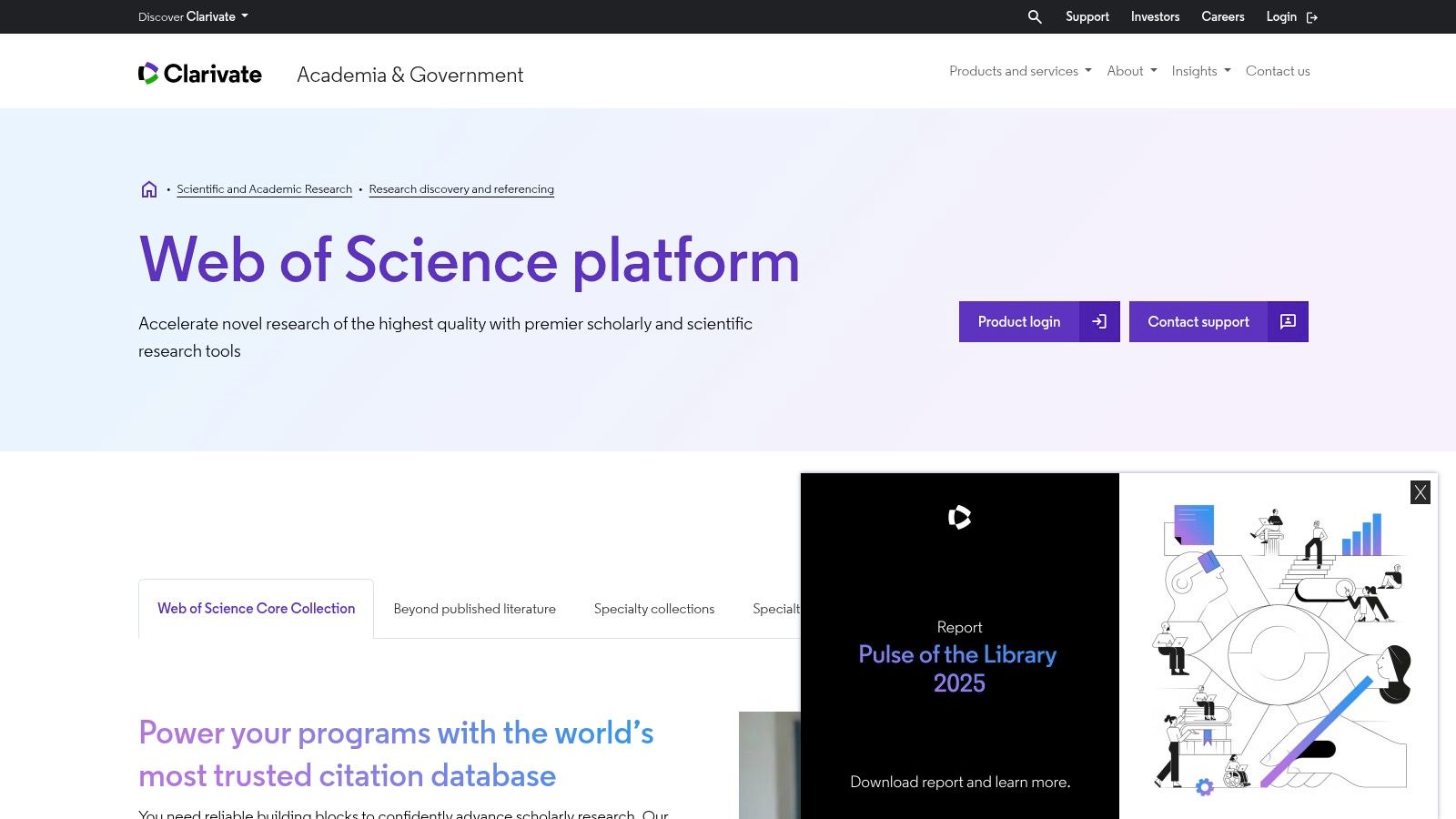
The Web of Science Research Assistant enhances its utility for AI-driven discovery. This tool uses natural-language querying to identify seminal works and influential authors. For an AI search strategy, this means you can quickly map the core research that underpins a topic, ensuring your content references the most authoritative sources.
Mini Case Study
A B2B SaaS company in the medical device space used the WoS API to feed citation data into its internal knowledge graph. By tracking citations of their own white papers, they identified key opinion leaders and influential institutions. This data directly informed their content strategy, helping them create articles that reference authoritative studies. This strengthened their topical authority for AI search engines like Perplexity and Google's SGE.
| Feature | Details |
|---|---|
| Data Quality | Highly curated Core Collection with stable, high-integrity metadata ideal for mission-critical AI models. |
| Research Assistant | Enables natural-language queries and topic mapping to speed up literature discovery. |
| Access & Integration | Primarily via institutional subscription; offers robust APIs and data export (XML, InCites) for pipelines. |
| Pricing Model | Enterprise/Institutional; no public pricing. Access is often through a university or corporate library. |
- Pros: Excellent data integrity and historical depth. Strong institutional adoption and enterprise-level support.
- Cons: Requires an institutional subscription, limiting access for small teams.
Link: clarivate.com/webofsciencegroup/solutions/webofscience-platform/
3. Elsevier Scopus
Elsevier's Scopus is a massive multidisciplinary citation database. For AI search optimization, its strength lies in its extensive coverage and robust author and journal-level metrics, such as the h-index and CiteScore. This data provides a rich, quantitative foundation for identifying influential research. The platform’s analytics are especially useful for benchmarking your own content's scholarly impact.
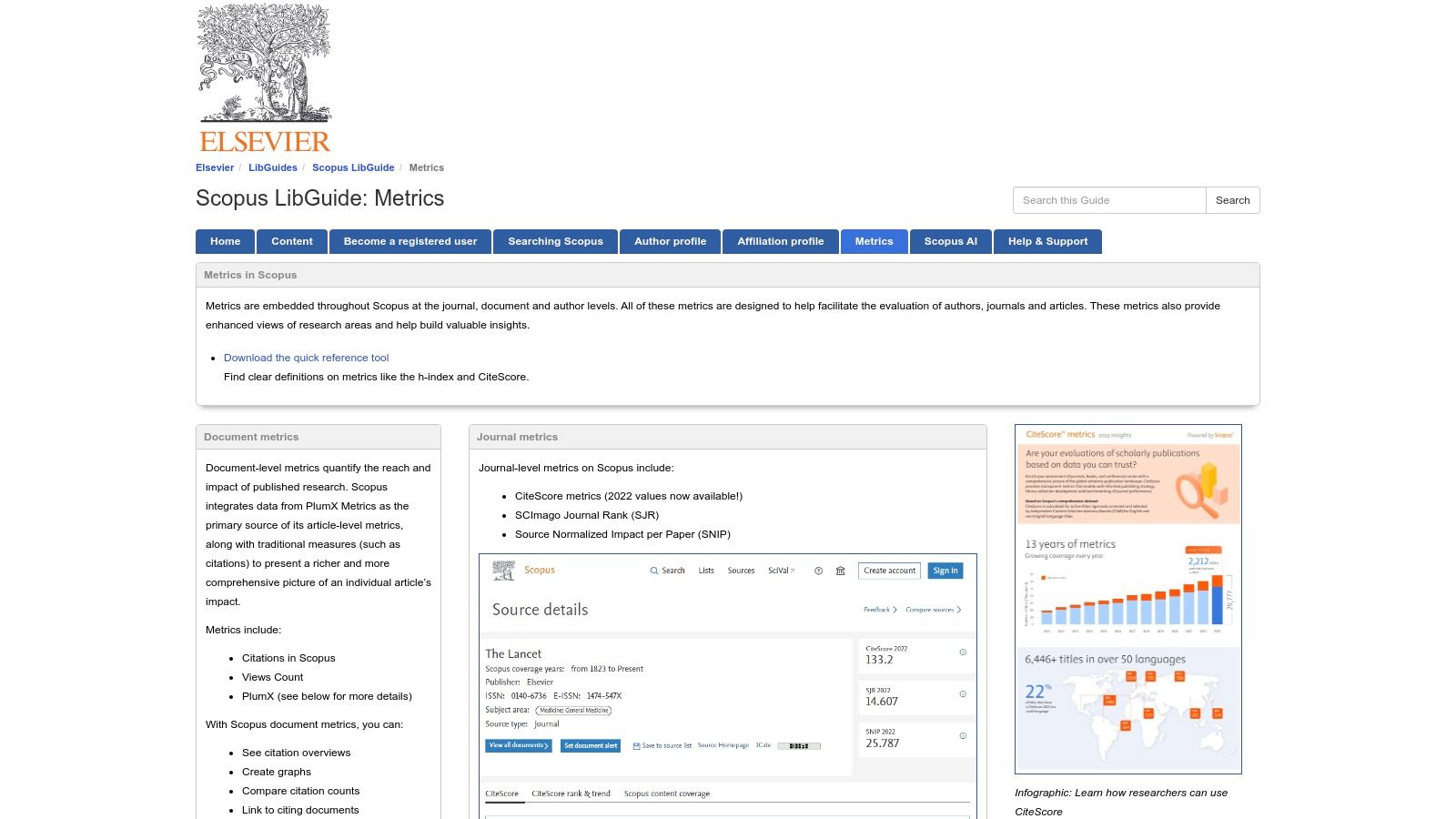
Scopus excels with its powerful author disambiguation and trend analysis tools. By tracking citation velocity and analyzing research trends, you can create forward-looking content that anticipates user queries in AI-native search environments. Its integration with PlumX also adds altmetrics, offering a broader view of a paper's influence beyond traditional citations.
Mini Case Study
A fintech company creating educational content on quantitative finance used the Scopus API to analyze citation networks of top economic journals. By identifying the most frequently cited authors on topics like algorithmic trading, they built a content strategy that referenced these foundational works. This created highly credible articles, signaling expertise and trustworthiness to AI models like Google's SGE.
| Feature | Details |
|---|---|
| Data & Metrics | Extensive coverage with document, author, and journal metrics (h-index, CiteScore) for robust analysis. |
| Author Tools | Strong author disambiguation and trend analysis tooling to identify influential experts and emerging topics. |
| Access & Integration | Institutional subscription model; offers a comprehensive API and data exports for custom analytics. |
| Pricing Model | Institutional/Enterprise subscription; no public pricing. Access is generally through corporate or academic libraries. |
- Pros: Strong tooling for trend analysis and author disambiguation. Well-documented librarian guidance.
- Cons: Typically requires an institutional license to access.
Link: elsevier.libguides.com/scopus/metrics
4. Elsevier SciVal
Elsevier's SciVal is a high-level research analytics suite built upon the Scopus database. SciVal provides macro-level insights into research trends and influential topic clusters. Rather than focusing on individual papers, it excels at deriving field-normalized signals, allowing content teams to benchmark the impact of research areas and identify which topics are gaining traction.
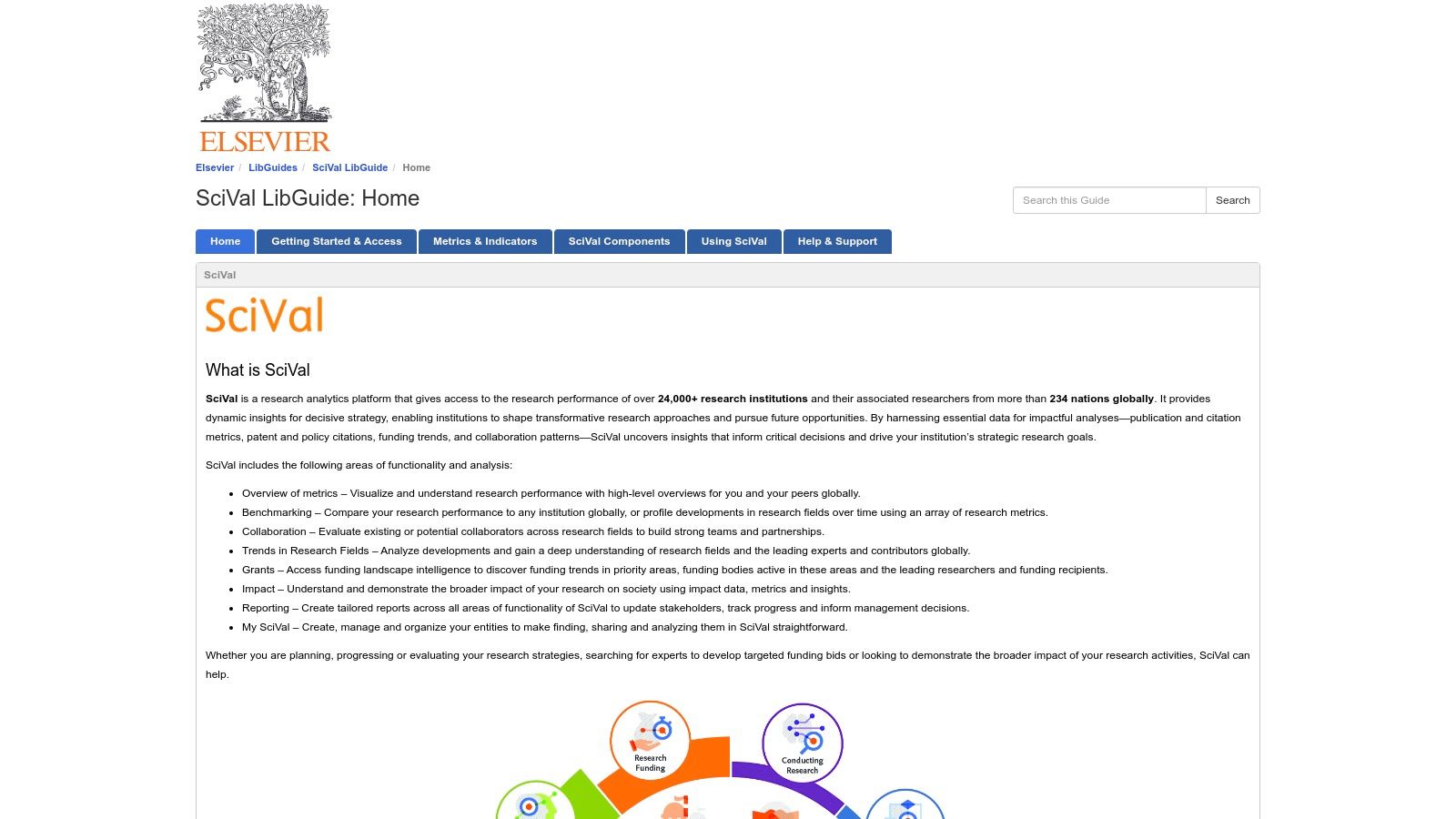
Its strength lies in institutional benchmarking. Features like the Field-Weighted Citation Impact (FWCI) offer a nuanced view of a paper's importance relative to its specific field, a critical metric for weighting sources in an AI retrieval system. SciVal can reveal emerging research fronts and key institutional players, ensuring your material is aligned with the most current science. This makes it one of the best citation analysis options for optimizing AI search at a strategic level.
Key Use Case & Implementation
A B2B enterprise in the sustainable energy sector can use SciVal to identify the top research institutions related to battery technology. By analyzing FWCI and collaboration networks, their content team can prioritize partnerships with leading universities and create expert-led content. This data-driven approach helps them build topical authority that is recognized by AI search models.
| Feature | Details |
|---|---|
| Data Source | Built on weekly refreshed Scopus data, providing up-to-date trend analysis and impact metrics. |
| Normalized Metrics | Offers Field-Weighted Citation Impact (FWCI) and other indicators to compare research impact across disciplines. |
| Topic Discovery | Identifies prominent and emerging topic clusters to inform content strategy and R&D focus. |
| Access & Integration | Primarily via institutional subscription with custom pricing; provides data exports for strategic planning. |
- Pros: Mature dashboards are excellent for institutional strategy. Helpful for identifying high-impact source domains.
- Cons: Only available via institutional subscription. Not designed for individuals or small businesses.
Link: elsevier.libguides.com/SciVal
5. Digital Science Dimensions
Digital Science Dimensions offers a more holistic view by linking publications to grants, patents, clinical trials, and policy documents. This interconnected "research graph" is a powerful asset for optimizing AI search. You can identify which research is actively being funded or patented, providing a forward-looking signal of topical authority.
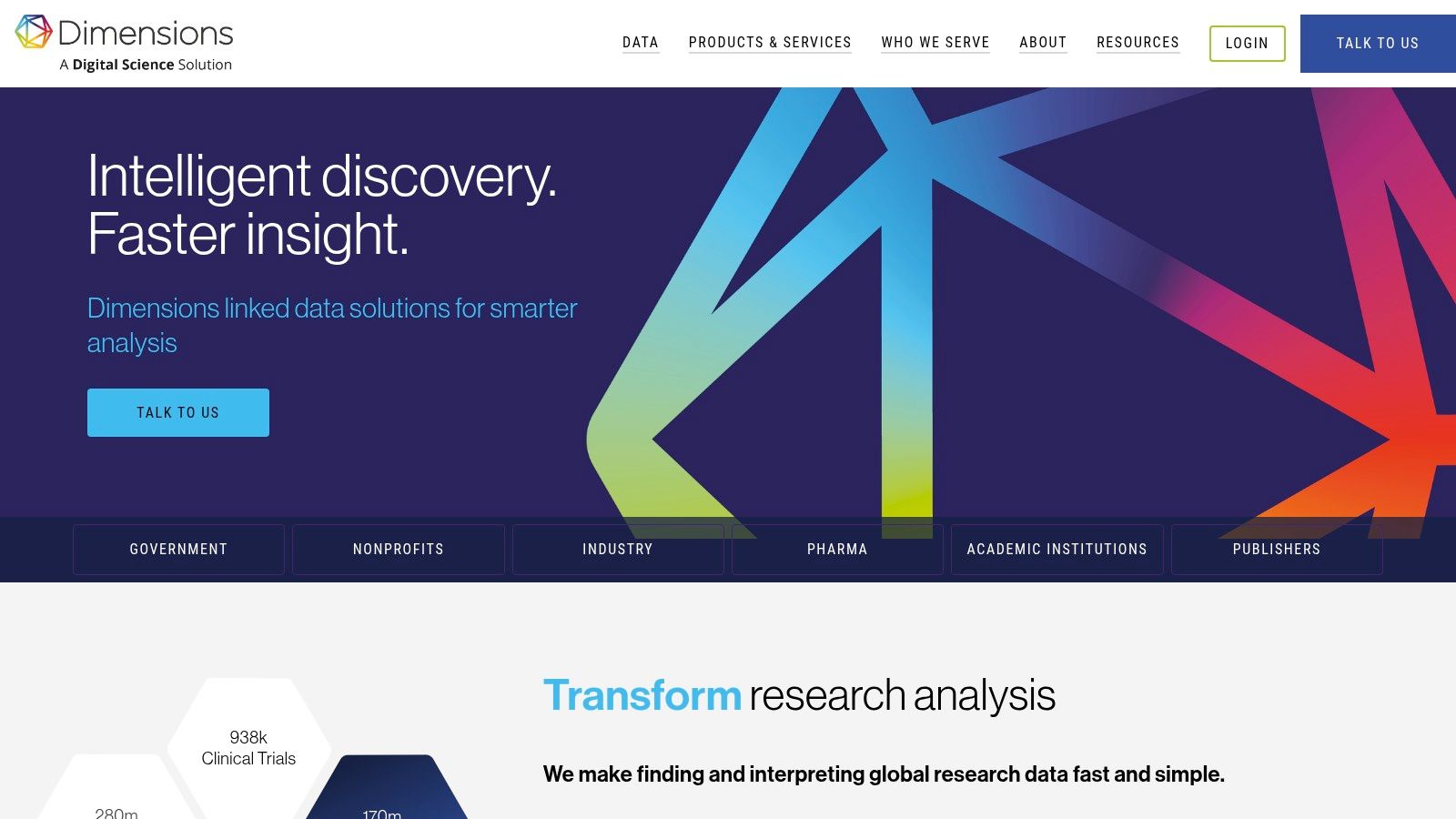
Dimensions' flexible access tiers make it one of the most versatile citation analysis options for optimizing AI search. The free Metrics API is excellent for smaller teams, while the subscription-based Analytics API and BigQuery access enable large-scale data pipelines. Using its specialized Dimensions Search Language (DSL), developers can programmatically query the entire graph to uncover unique connections.
Key Use Case & Implementation
A fintech company building a content hub around blockchain can use the Dimensions API to identify the most-cited patents and university research grants. By analyzing these entities alongside publications, they can create expert-level content. This multi-faceted authority signal is highly valuable for establishing trust with sophisticated AI search systems.
| Feature | Details |
|---|---|
| Data Scope | Integrated research graph connecting publications with patents, grants, and clinical trials. |
| Access & Integration | Multiple tiers: Free Metrics API, subscription Analytics API (DSL), and enterprise-scale BigQuery access. |
| Query Language | The Dimensions Search Language (DSL) enables complex, programmatic queries across linked data types. |
| Pricing Model | Freemium; Metrics API is free for non-commercial use, while Analytics and BigQuery require paid subscriptions. |
- Pros: Broad entity coverage beyond just academic publications. Flexible access with a free tier.
- Cons: Full API and BigQuery access require a significant subscription.
Link: https://www.dimensions.ai/
6. The Lens
The Lens is a unique public-interest platform bridging scholarly research and patent literature. Its open scholarly citation graph allows teams to prototype and test citation-aware AI search strategies without an enterprise subscription. For companies in tech or biotech, The Lens provides a critical view into how academic research translates into commercial innovation.

The platform’s strength lies in its ability to fuse patent and paper data. Its scholarly analysis dashboards and visualizations are useful for identifying influential patents that cite key academic papers. This linkage is a powerful signal for AI search engines, grounding content in both foundational research and real-world application.
Key Use Case & Implementation
A renewable energy startup can use The Lens's free analysis tools to map the relationship between academic papers on solar cell efficiency and patents filed by major industry players. This analysis reveals which research is driving commercial development. Their content team can then create in-depth articles that reference the key patents, positioning their content as a highly authoritative resource.
| Feature | Details |
|---|---|
| Patent-Paper Linkage | Fuses scholarly works and global patent data, providing a unique dataset for innovation-focused AI grounding. |
| Analysis Tools | Interactive dashboards and visualizations for influence mapping and contextual analysis. |
| Access & Integration | Generous free access for individual use; offers a powerful Aggregation API for programmatic metrics. |
| Pricing Model | Free for public use. Paid "Lens Cooperative" and "Workspace" plans offer advanced features and API access. |
- Pros: Generous free access is excellent for rapid prototyping. The patent–paper linkage enriches AI ranking signals.
- Cons: Advanced analysis and API features are moving to a paid model.
Link: www.lens.org/
7. OpenAlex
OpenAlex is a fully open and free scholarly graph. For teams optimizing AI search, its CC0 license is a massive advantage, eliminating licensing complexities when using its data to train models or power RAG systems. The platform indexes hundreds of millions of works, authors, and institutions, providing a comprehensive citation network.
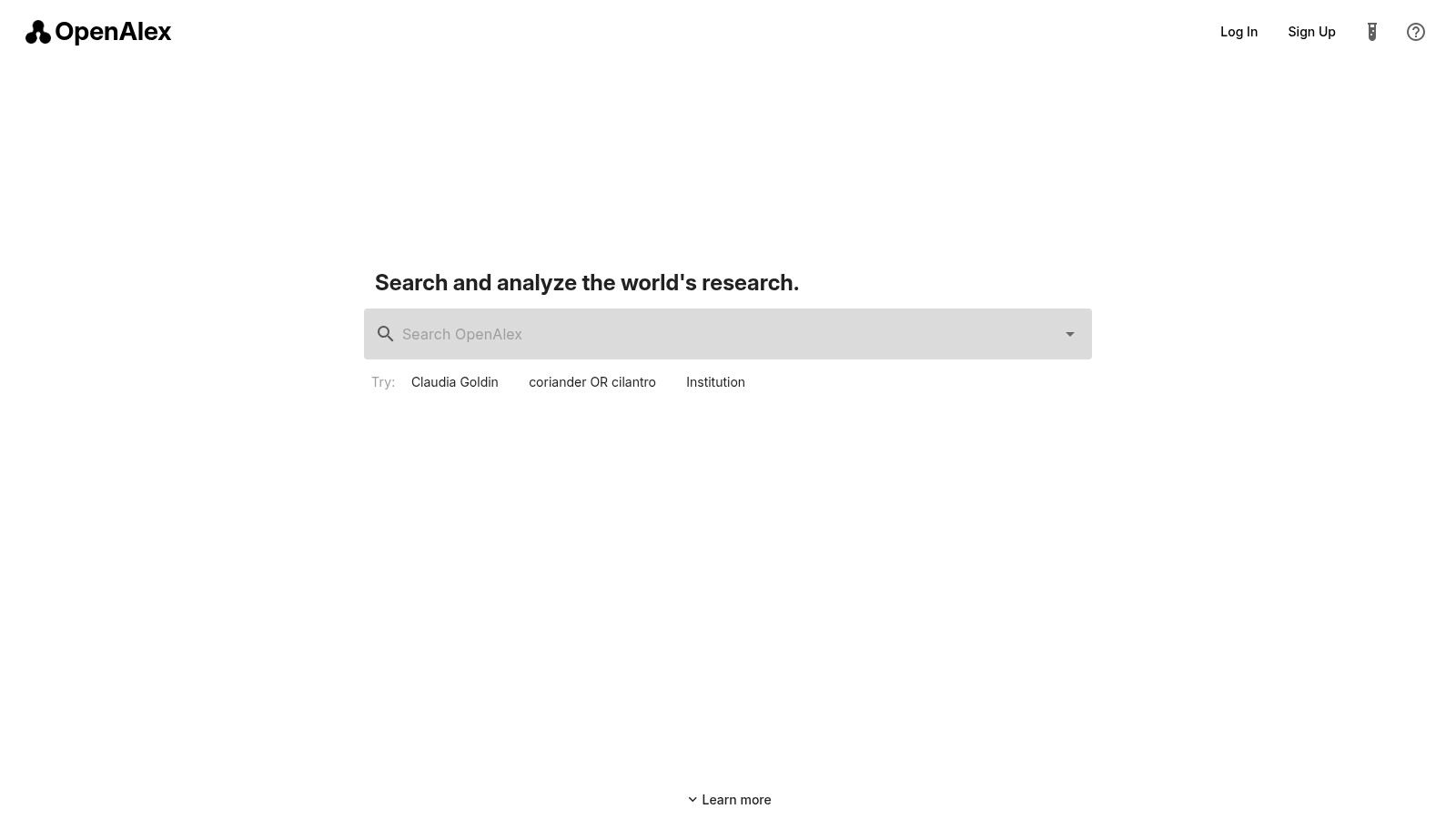
OpenAlex offers its entire dataset as a monthly snapshot on AWS S3, alongside a well-documented public API. This accessibility makes it one of the best citation analysis options for developers and startups building custom AI search tools. The platform’s active community and client libraries lower the barrier to entry for integrating large-scale citation data.
Key Use Case & Implementation
A startup developing a niche AI-powered search engine can download the full OpenAlex snapshot to build its foundational knowledge graph. By analyzing citation links, they can pre-calculate authority scores for different topics. When a user queries their system, these scores help rank sources, ensuring the AI surfaces content referencing influential research.
| Feature | Details |
|---|---|
| Data Quality | Massive, open graph derived from multiple sources; data is machine-readable and linked. |
| Open Ecosystem | Free public API and full data snapshots (AWS) with CC0 license, ideal for commercial AI applications. |
| Access & Integration | Extensive API documentation, LLM usage guides, and multiple client libraries (Python, R, etc.). |
| Pricing Model | Free with a "polite" rate limit; premium tiers are available for higher rate limits and faster updates. |
- Pros: Completely free and open (CC0 license) simplifies commercial reuse. Excellent developer support.
- Cons: Default API rate limits may be too slow for high-volume applications without a premium plan.
Link: https://openalex.org/
8. Semantic Scholar
Semantic Scholar, from the Allen Institute for AI, offers a powerful, AI-driven academic search engine and a wealth of structured data. For teams optimizing for AI search, its major advantage is its programmatic access via a public API and downloadable bulk datasets. This allows for direct integration of scholarly data into internal knowledge graphs or RAG systems.

The platform uses machine learning to extract key information from papers, making it one of the best citation analysis options for large-scale projects. By providing the Semantic Scholar Academic Graph (S2AG) dataset, it uniquely empowers organizations to perform offline modeling and train proprietary systems on a massive corpus without constant API calls.
Key Use Case & Implementation
A tech startup can download the S2AG bulk dataset to build a specialized knowledge base. By analyzing citation patterns, they can identify foundational research. This intelligence informs their content calendar, ensuring they publish articles that cite influential studies, thereby signaling deep expertise to AI-driven search platforms.
| Feature | Details |
|---|---|
| Data Access | Public API for real-time data and bulk S2AG datasets for offline training and large-scale analysis. |
| Data Quality | AI-enhanced corpus with extracted paper, citation, and author data; strong coverage across many domains. |
| Access & Integration | Free public API access; API keys are available to increase rate limits for higher-throughput applications. |
| Pricing Model | Free for public and research use; access to certain endpoints and higher throughput may require coordination. |
- Pros: Highly accessible via a public API and free bulk datasets. Excellent for large-scale, programmatic analysis.
- Cons: High-volume API usage requires obtaining a key. Data quality can vary more than in curated databases.
Link: www.semanticscholars.org/product/api
9. Crossref
Crossref is not a citation index but a foundational piece of scholarly infrastructure. As the official Digital Object Identifier (DOI) registration agency, it provides the canonical, publisher-supplied metadata for academic content. Its free, high-volume REST API allows AI systems to resolve DOIs and enrich documents with authoritative metadata, ensuring sources are accurate and traceable.
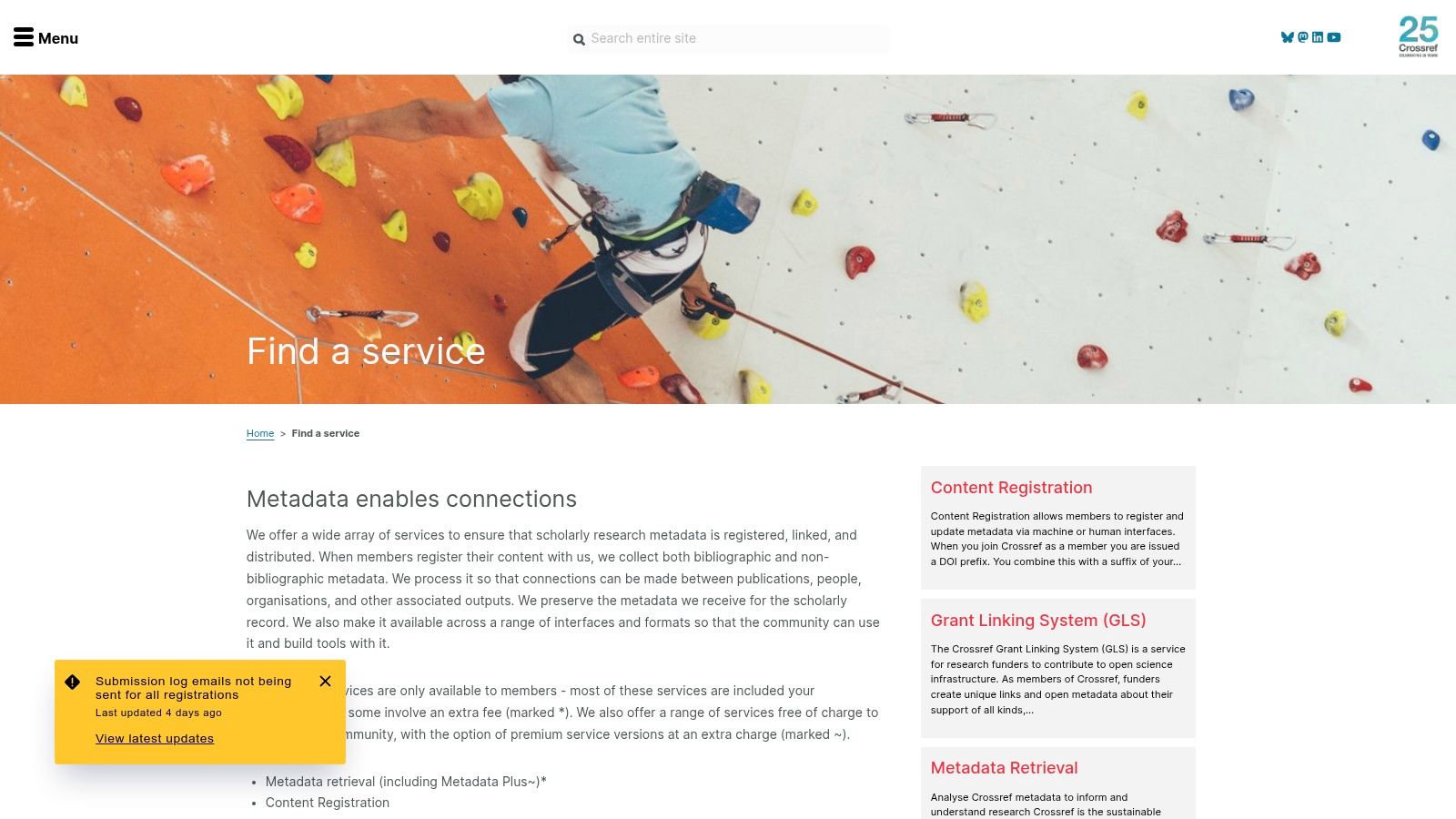
This direct link to publisher data is a powerful trust signal for AI search engines. While it doesn't analyze citation networks, Crossref provides the raw, verified metadata that other platforms build upon. For teams building knowledge bases, its API is often the first step in hydrating a reference list with stable, correct information. This makes it one of the best citation analysis options for programmatic accuracy.
Key Use Case & Implementation
An AI research assistant can use the Crossref REST API to build a reliable reference validation module. When a user inputs a DOI, the system queries Crossref to fetch official metadata. This process verifies the paper, corrects errors, and enriches the entry with a link to the publisher's version. This ensures the AI assistant's outputs are built on verified sources.
| Feature | Details |
|---|---|
| Data Source | Canonical publisher-supplied metadata linked to DOIs, ensuring the highest level of source accuracy. |
| Access & API | A free, high-volume REST API is available for public use, with a polite service level for all users. |
| Metadata Plus | Paid service offering dedicated support, higher SLAs, and monthly data snapshots for intensive use cases. |
| Pricing Model | API is free; Metadata Plus is a paid subscription. Transparent fee schedules are publicly available. |
- Pros: Provides the authoritative, canonical source of DOI metadata. Predictable and well-documented API.
- Cons: Not a full citation index; it provides metadata but not citation links.
Link: https://www.crossref.org/services/
10. OpenCitations
OpenCitations provides public access to global scholarly citation data, making it a powerful, license-friendly option for AI development. Its core value is its commitment to open data, offering machine-readable citation indexes via REST APIs and downloadable datasets. The platform’s open ethos ensures data can be freely reused and integrated into commercial applications.
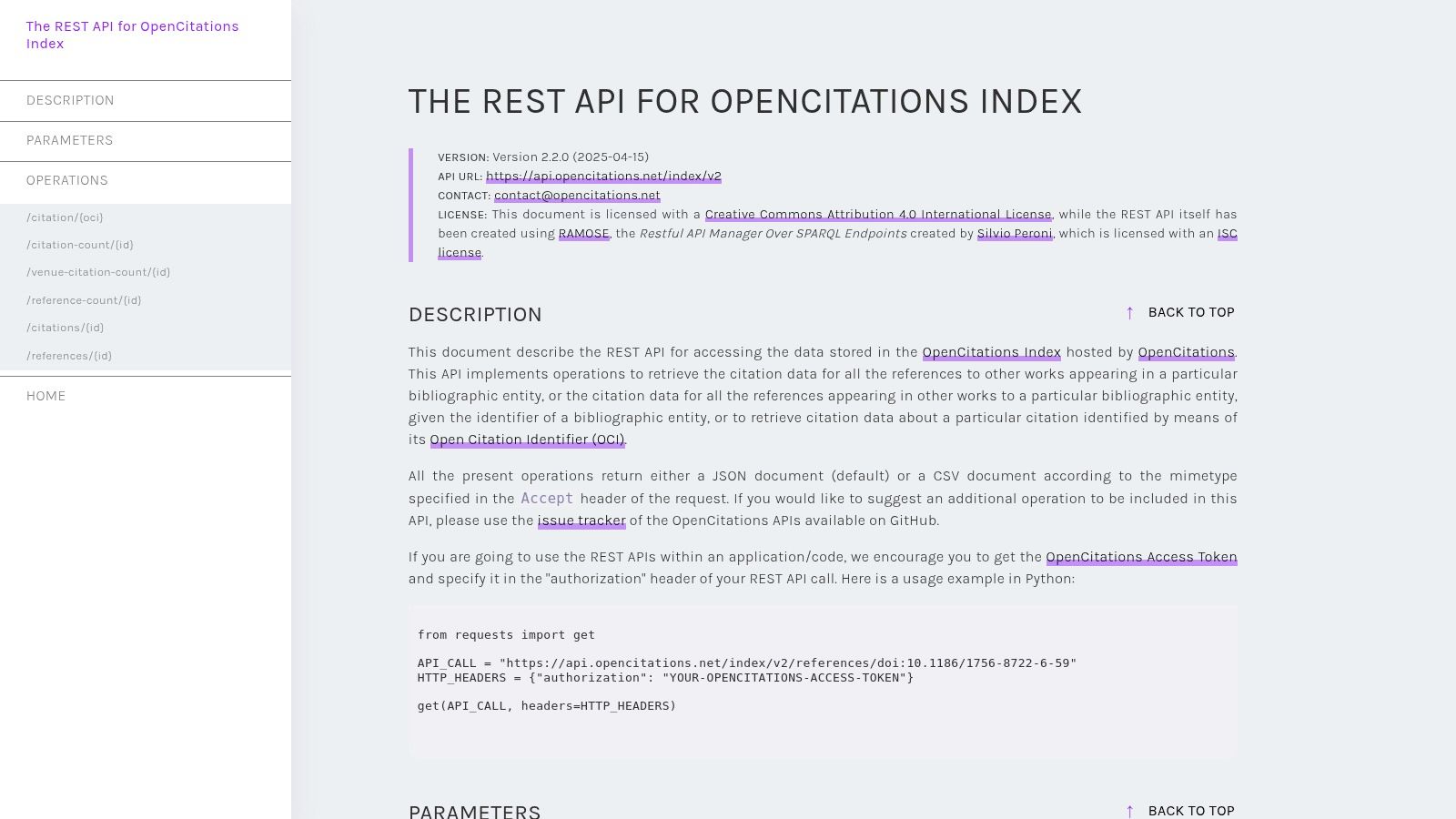
A standout feature is the Citations in Context Collection (CCC), which provides the actual in-text snippets where a citation occurs. This contextual data is invaluable for training LLMs to understand why a source was cited, significantly improving the reasoning of AI-generated answers. Understanding this context is a key part of leveraging AI citations for better search performance.
Key Use Case & Implementation
An AI-native search engine startup can use OpenCitations' COCI dataset as a foundational layer for its knowledge graph. By ingesting the citation graph, they can model relationships between entities without licensing fees. They can further enhance their model by using the CCC dataset to train their LLM to generate more accurate summaries.
| Feature | Details |
|---|---|
| Data Accessibility | Completely open and free via REST APIs (with optional tokens for higher reliability) and bulk downloads. |
| Citation Context (CCC) | Provides in-text citation snippets, crucial for training AI models on the reasoning behind a reference. |
| Data Formats | Offers data in various formats including SPARQL endpoints, CSV, and RDF, suitable for diverse data pipelines. |
| Pricing Model | Free; it is a non-profit, community-driven infrastructure. |
- Pros: Open-data ethos allows for easy, compliant reuse in AI products. In-text citation context offers a unique advantage.
- Cons: Coverage can be less comprehensive than paywalled indexes.
Link: opencitations.net/index/api/v2
11. scite
scite moves beyond simple citation counts to evaluate the context of a citation. The platform uses AI to classify how a publication cites another, categorizing it as "supporting," "contrasting," or "mentioning." This contextual layer allows content teams to identify and reference studies that are not just frequently cited, but also widely supported by the academic community.
This distinction is critical for establishing authoritativeness. By focusing on sources with strong supporting evidence, you can create more trustworthy content. scite’s Smart Citations provide a clear path to finding and validating the foundational evidence for any topic, ensuring your content is built on a solid research base.
Key Use Case & Implementation
A B2B content team in fintech can use scite to vet sources for a white paper on blockchain security. Instead of citing a popular study, they can use scite's API to confirm it has a high number of supporting citations. This strengthens their E-E-A-T signals for AI search engines, making it more likely their content will be used to generate authoritative answers. You can explore how such signals impact visibility in our guide on how to rank in ChatGPT.
| Feature | Details |
|---|---|
| Smart Citations | AI-driven intent labels (supporting, contrasting, mentioning) provide deep contextual signals for evidence. |
| Citation Context | Displays the full-text snippet where the citation occurs, allowing for rapid validation of evidence. |
| Access & Integration | Web app, browser extension, and API access for integrating citation context into internal knowledge systems. |
| Pricing Model | Tiered subscription model for individuals and institutions; full API access is typically for enterprise-level plans. |
- Pros: Provides unique citation intent signals not found in most other databases. Helps quickly validate the strength of a research claim.
- Cons: Full API access is locked behind expensive plans.
Link: scite.ai
12. Litmaps
Litmaps offers a visual approach to citation analysis, transforming a "seed paper" into an interactive map of its scholarly neighborhood. It generates visual networks that show how research is connected, making it exceptionally fast to identify seminal works and track a topic's evolution. For AI search optimization, this provides a powerful way to quickly scope a field and build a relevant corpus of authoritative sources.
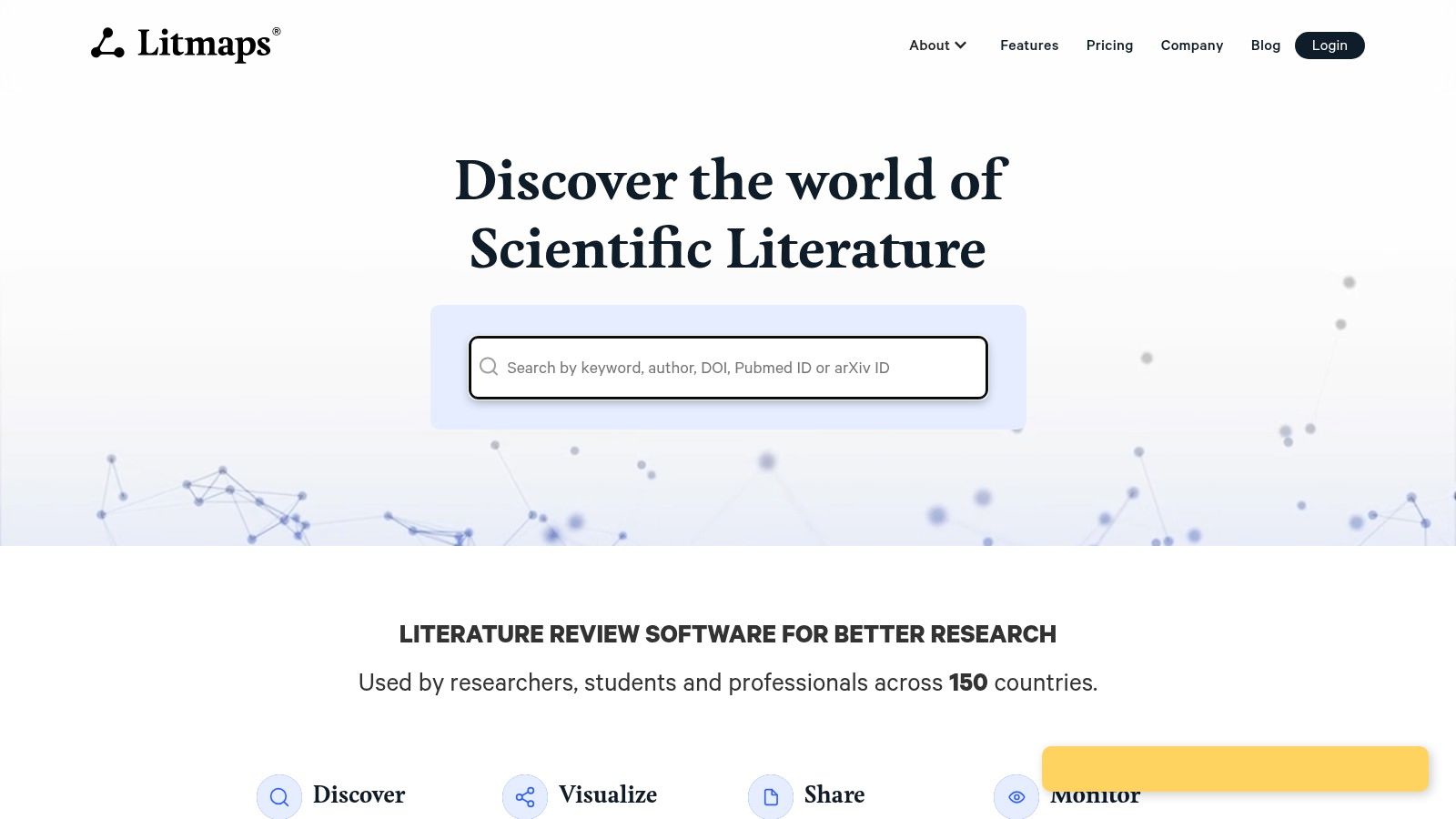
The platform's strength lies in its discovery and alerting capabilities. Once a map is created, you can set up alerts to be notified of new, relevant papers. This automated monitoring is invaluable for keeping an internal knowledge base or AI index current. It ensures your systems are continuously updated with the latest research without manual effort.
Key Use Case & Implementation
A digital marketing agency specializing in AI SEO can use Litmaps to rapidly build a "source of truth" for a new client's niche. Starting with a few key industry papers, they generate a visual map to identify the most-cited authors. This curated list is then used to brief content writers, ensuring all new blog posts reference core, authoritative works.
| Feature | Details |
|---|---|
| Data Quality | Visual citation maps and discovery built from a seed paper; depends on upstream source coverage. |
| Research Assistant | Configurable alerts and unlimited maps on paid tiers to keep AI indexes and corpora current. |
| Access & Integration | Web-based with collaboration options for teams; offers education discounts for individual researchers. |
| Pricing Model | Freemium model; affordable Pro and Teams tiers with monthly/annual subscriptions available publicly. |
- Pros: Fast way to scope a field and generate curated corpora for AI. Affordable Pro tier.
- Cons: Not a full citation index; relies on upstream source coverage.
Link: www.litmaps.com/
Which Citation Analysis Tool Is Right For You?
| Product | Core features | Quality ★ | Price/Value 💰 | Target 👥 | Unique selling points ✨ |
|---|---|---|---|---|---|
| AI SEO Tracker 🏆 | LLM visibility, Page Inspector, SOV & ROI dashboards, prescriptive playbooks | ★★★★★ outcome-focused | Free AI scan; tiered plans (contact) 💰 | 👥 SaaS marketers, SEO & growth teams, agencies | ✨ Shows where your brand appears in LLM answers; page parse tests; ROI modeling |
| Clarivate Web of Science (Research Assistant) | Curated citation index, NL queries, co‑citation visualizations, APIs | ★★★★★ institutional-grade | Institutional subscription; custom quoting 💰 | 👥 Universities, research offices, enterprises | ✨ Deep historical coverage & high-quality metadata |
| Elsevier Scopus | Document/author/journal metrics, author disambiguation, PlumX | ★★★★ | Institutional license required 💰 | 👥 Librarians, researchers, institutions | ✨ Robust author metrics & trend tooling |
| Elsevier SciVal | Institution dashboards, FWCI, topic discovery, weekly Scopus refresh | ★★★★ | Institutional subscription; custom pricing 💰 | 👥 Research strategists, university leadership | ✨ Field‑weighted impact and topic clusters |
| Digital Science Dimensions | Research graph (pubs/grants/patents), Analytics & Metrics APIs, BigQuery | ★★★★ | Free metrics API + paid analytics/BigQuery 💰 | 👥 Data teams, institutions, AI builders | ✨ Broad entity linkage beyond publications |
| The Lens | Scholarly + patent graph, analysis dashboards, Aggregation API | ★★★★ | Generous free access; paid workspaces 💰 | 👥 Innovators, IP researchers, prototypers | ✨ Patent–paper linkage for innovation grounding |
| OpenAlex | CC0 scholarly graph, REST API, monthly full snapshots | ★★★★ | Free CC0 access; premium rate tiers 💰 | 👥 Developers, reproducible AI pipelines | ✨ Open license + full data snapshots |
| Semantic Scholar | Public API, bulk datasets (S2AG), frequent updates | ★★★★ | Free API (keys to raise limits); bulk datasets 💰 | 👥 Researchers, ML teams, integrators | ✨ Easy start + downloadable corpora for modeling |
| Crossref | DOI metadata REST API, Metadata Plus (paid SLA & snapshots) | ★★★★ | Free API; Metadata Plus for SLAs 💰 | 👥 Publishers, RAG systems, bibliometric pipelines | ✨ Canonical publisher-supplied DOI metadata |
| OpenCitations | Open citation indexes (COCI), REST/SPARQL, downloadable dumps | ★★★ | Free/open data; optional tokens for reliability 💰 | 👥 Compliance-conscious AI teams, researchers | ✨ In-text citation contexts (CCC) for grounding |
| scite | Smart citation intent labels, context windows, API & integrations | ★★★★ | Org/enterprise plans for full API; limited personal plans 💰 | 👥 Librarians, researchers, AI verification teams | ✨ Citation intent (support/contrast) to weight evidence |
| Litmaps | Visual citation maps, seed-paper discovery, alerts & collaboration | ★★★ | Free/Pro tiers; academic discounts 💰 | 👥 Researchers, students, teams curating corpora | ✨ Fast literature mapping & alerting for corpora building |
Your Next Move: From Analysis to Action
Optimizing for AI search is a data-driven process of proving your content's authority. Citations are the primary currency of that authority.
The most critical takeaway is that not all citation analysis tools serve the same purpose. A researcher building a knowledge graph has different needs than a SaaS marketer trying to get a pricing page cited in an LLM’s answer. The former might choose the API-first OpenAlex, while the latter needs the direct, competitive insights from a platform like AI SEO Tracker.
Choose a tool that solves your specific problem, not one that just drowns you in data.
An Actionable Plan To Get Cited
-
Define Your "Citation-Worthy" Assets: Identify the pages on your site that should be cited. This includes your homepage, core feature pages, pricing tables, and original research. These are your high-priority targets.
-
Conduct a Competitive Citation Audit: Select your top three competitors. Use a tool like AI SEO Tracker or scite to analyze who is citing their key pages and why. Are they cited for specific statistics, product definitions, or comparisons? This reveals the content formats AI models are currently rewarding.
-
Prioritize Based on Gaps and Opportunities: Your audit will reveal where competitors are strong and where they are weak. If a competitor is consistently cited for a statistic, create a more comprehensive and up-to-date resource. If you find a topic where no one is being cited authoritatively, that's your chance to become the primary source.
This methodical approach moves you from passive analysis to active optimization. The goal is to make your content the most logical and reliable choice for an AI answering a user's query.
Ready to stop guessing and start measuring your visibility in AI search? While academic tools provide raw data, AI SEO Tracker is purpose-built to give marketers the actionable insights needed to get cited. See exactly which AI models are referencing your brand and your competitors, and get a clear roadmap for improvement. Start tracking your AI search performance today.

